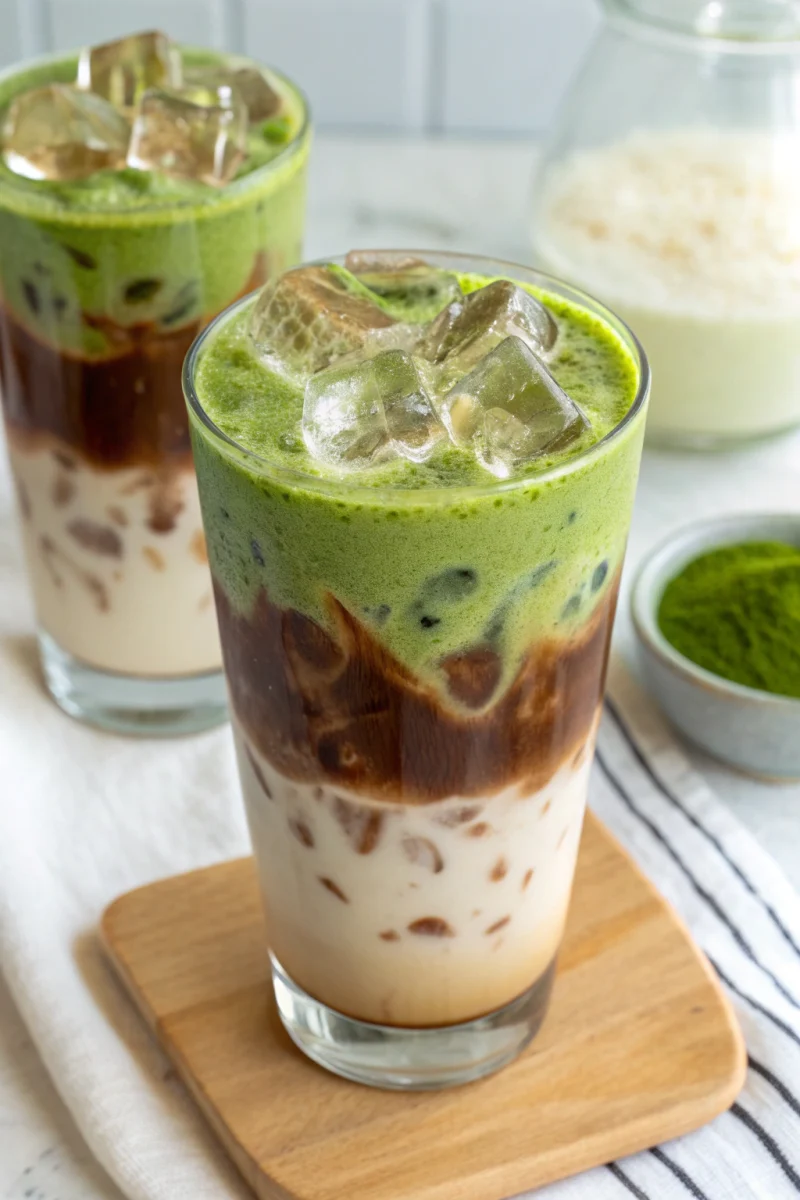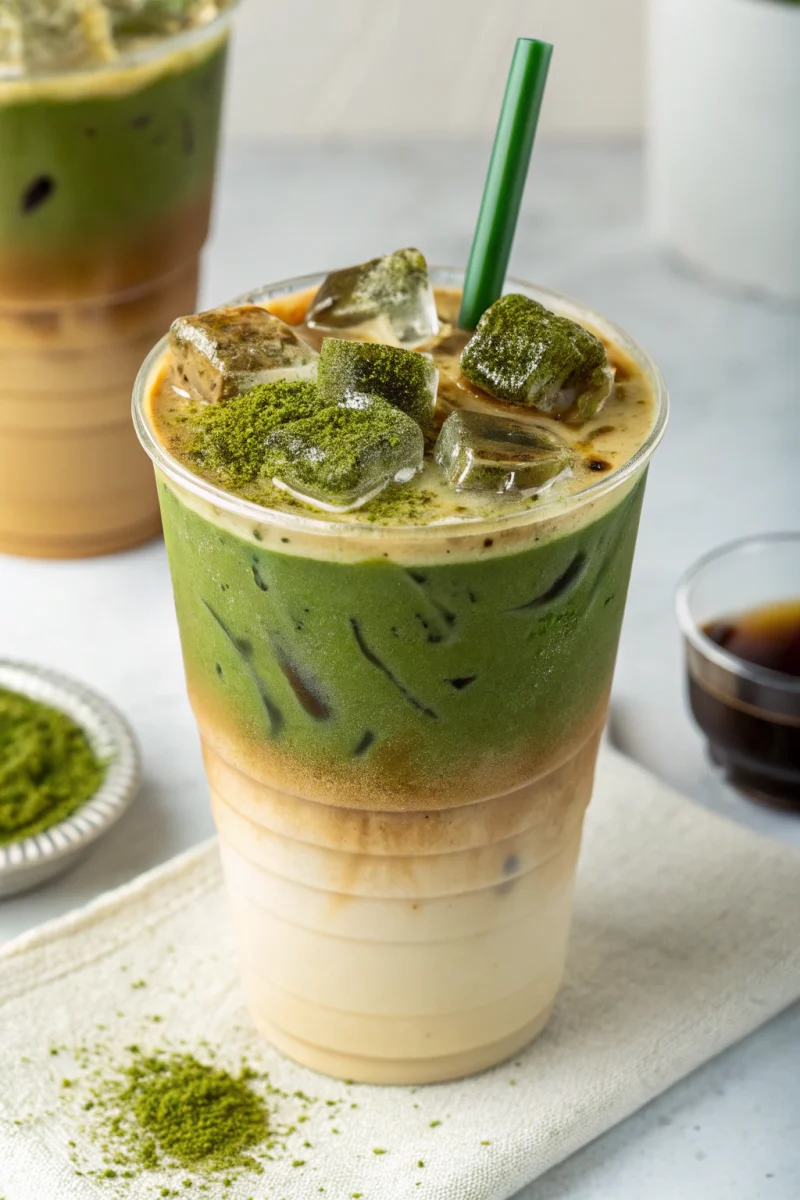5 Secrets to the Perfect Iced Matcha Espresso Fusion Recipe
Introduction
Iced Matcha Espresso Fusion is a drink that has quickly moved from niche coffee shops to the spotlight of social media feeds worldwide. At first glance, the mix of earthy Japanese matcha and bold Italian espresso may sound contradictory. Yet, this contrast is exactly what makes the drink compelling. It is a conversation between cultures, flavors, and textures, creating an energizing beverage that is as beautiful as it is complex. From its vibrant green-and-brown layered aesthetic to its harmonious balance of bitter, sweet, creamy, and umami, this recipe is more than a café trend—it is a modern ritual that you can master at home.
In this article, you’ll not only learn the step-by-step method but also uncover the cultural context, nutrition science, and barista tips that elevate your version from “good enough” to professional quality. By the end, you’ll understand the drink’s history, preparation nuances, storage advice, troubleshooting, seasonal twists, and pairing ideas that make it versatile and timeless.
Q: Why is the Iced Matcha Espresso Fusion trending?
A: Because it combines visual appeal, cultural storytelling, and a flavor profile that balances energy with calm focus—ideal for social media and lifestyle-conscious consumers.
Ingredients List

- 1 teaspoon Ceremonial Grade Matcha Powder: The foundation. Ceremonial grade ensures vibrant color and a smooth, less bitter flavor compared to culinary grade.
- 2 ounces Hot Water (175°F / 80°C): Hot enough to dissolve matcha without burning its delicate compounds.
- 1 shot (1.5 ounces) Freshly Brewed Espresso: Strong coffee essence with crema for visual layering.
- 6–8 ounces Milk of Choice: Whole dairy gives richness, oat milk adds body, almond milk keeps calories lower.
- 1–2 teaspoons Sweetener (optional): Maple syrup, honey, or classic simple syrup.
- Ice Cubes: Maintain chill and help with clean separation of layers.
Substitutions & Why They Matter:
- Matcha: If only culinary grade is available, whisk longer to reduce clumps. Expect a stronger grassy flavor.
- Espresso: Dark roast = chocolate and caramel notes. Light roast = fruity acidity. Choose based on mood.
- Milk: Soy milk creates stable froth, oat milk makes the creamiest texture, coconut milk adds tropical flair.
- Sweeteners: Agave for mild sweetness, stevia for zero-calorie balance, brown sugar syrup for depth.
Q: Can I use instant espresso instead?
A: Yes, dissolve it in hot water, but it won’t deliver the crema or layered texture of fresh espresso.
Prep Time
Prep: 5 minutes
Brew: 1 minute
Total: 6 minutes
This recipe is designed for efficiency. With a little practice, you can prepare matcha while your espresso machine brews, cutting total time to under 5 minutes.
Step-by-Step Preparation
Step 1: Whisk the Matcha
Sift matcha to prevent clumps. In a small bowl, whisk vigorously in 2 oz hot water using a bamboo whisk or frother. Aim for a foamy, jade-green surface. The aroma should be vegetal and slightly sweet, not bitter.
Step 2: Brew the Espresso
Use freshly ground beans, tamp evenly, and brew a single shot. Pay attention to crema—it helps the espresso float gracefully on top of matcha when poured correctly.
Step 3: Layer the Drink
Fill a tall glass with ice. Add your milk of choice, sweetener if desired, and then gently pour whisked matcha. Finally, float the espresso slowly over the back of a spoon. Watch as three layers—white, green, and brown—emerge like art in a glass.
Q: Why pour espresso last?
A: Density. Milk is heaviest, matcha is lighter, and espresso is lightest. Pouring last ensures defined layers.
Nutritional Profile
One 12 oz serving (unsweetened almond milk) provides:
- Calories: ~80
- Fat: 3–4 g
- Carbohydrates: 8–10 g
- Protein: 2 g
- Caffeine: 150–200 mg (equivalent to ~2 cups of tea or 1.5 cups of coffee)
With whole milk, calories rise to ~150 and protein to ~6 g. Sweeteners increase carbs depending on type.
Nutrition Deep Dive
Matcha contains EGCG, a catechin known for antioxidant and anti-inflammatory effects. Espresso adds chlorogenic acids and polyphenols, both linked to metabolic health. Together, they create synergy: caffeine stimulates alertness, while matcha’s L-theanine induces calm focus. Scientific studies (NCBI) show that this combination may enhance memory, reduce stress, and improve sustained concentration.
Q: How much caffeine is too much?
A: Most adults can safely consume up to 400 mg daily (FDA). This drink provides ~200 mg, about half the daily safe limit.
Make-Ahead & Storage
For convenience, whisk matcha in advance and refrigerate for up to 24 hours. Brew espresso fresh when possible, but chilled shots last up to 6 hours. Never pre-mix the layers: the drink loses its signature look quickly once combined.
Troubleshooting Common Mistakes
- Clumpy Matcha: Always sift and whisk vigorously.
- Muddy Layers: Pour espresso too quickly, or not enough ice.
- Excess Bitterness: Use ceremonial matcha and medium-dark espresso beans.
- Flat Taste: Espresso beans may be stale. Always grind fresh.
- Over-sweetening: Too much syrup masks the balance of flavors.
Barista Secrets
- Chill your glass for sharper layers.
- Use filtered water for cleaner matcha taste.
- Experiment with espresso roast: lighter roasts highlight fruit, darker ones emphasize chocolate.
- For dramatic layers, use clear block ice rather than small cubes.
Creative Variations
- Vanilla Bean Fusion: Add 1 tsp vanilla syrup for a dessert-like twist.
- Caramel Delight: Blend caramel syrup into milk for indulgence.
- Holiday Peppermint: A drop of peppermint extract makes it festive.
- Protein Boost: Mix protein powder into milk for a post-workout option.
- Spiced Fusion: Add cinnamon or chai spices for warmth.
Cultural Context
Matcha dates back to 12th-century Japanese Zen traditions, where monks valued its ability to sustain meditation. Espresso emerged in 20th-century Italy as a quick, social way to enjoy concentrated coffee. Today, their fusion symbolizes globalization: a meeting of East and West, old and new, ritual and speed. It reflects how cafés innovate by reinterpreting heritage drinks into new formats suited for modern lifestyles.
Perfect Pairings
The drink pairs well with:
- Breakfast: Avocado toast, overnight oats, granola.
- Brunch: Croissants, bagels, or a rustic vegetable galette.
- Dessert: Pairs beautifully with tiramisu or matcha cookies.
Q: Can I serve it with savory foods?
A: Yes, its bitterness complements rich dishes like quiches or smoked salmon bagels.
Conclusion
The Iced Matcha Espresso Fusion isn’t just another café drink—it’s a symbol of global culinary creativity. By combining the meditative depth of Japanese tea with the energetic punch of Italian coffee, it delivers a drink that is layered in both flavor and meaning. With the right ingredients, careful technique, and a bit of experimentation, you can turn your kitchen into a café and enjoy this modern ritual whenever you crave a balance of calm and energy.
FAQ
Q1: Can I serve it hot?
A1: Yes. Skip the ice and use steamed milk instead. Layers will blur, but flavor balance remains.
Q2: What equipment is essential?
A2: A whisk for matcha, an espresso machine (or moka pot), and a tall glass. A digital thermometer helps with water precision.
Q3: How do I reduce calories?
A3: Use unsweetened almond milk and skip syrup. The drink remains flavorful and refreshing.
You Might Also Like
Explore more refreshing recipes:
– Iced Dirty Matcha Latte
– Apple Chai Smoothie
– Pumpkin Spice Latte Overnight Oats
– Ginger Turmeric Shots
– Food Network Espresso Recipes

Food lover & recipe creator sharing simple, protein-rich recipes for busy lives.

